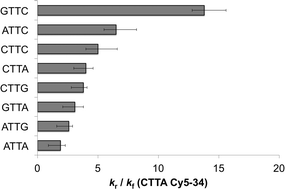Sequence-dependent thymine dimer formation and photoreversal rates in double-stranded DNA†
Abstract
The kinetics of

- This article is part of the themed collection: Interaction of UV radiation with DNA
* Corresponding authors
a Biophysics Program, The Ohio State University, Columbus, OH, USA
b
Department of Physics, The Ohio State University, Columbus, OH, USA
E-mail:
mpoirier@mps.ohio-state.edu
c Department of Chemistry and Biochemistry, The Ohio State University, Columbus, OH, USA
d
Department of Chemistry and Biochemistry, Montana State University, Bozeman, MT, USA
E-mail:
kohler@chemistry.montana.edu
The kinetics of

 Please wait while we load your content...
Something went wrong. Try again?
Please wait while we load your content...
Something went wrong. Try again?
Y. K. Law, R. A. Forties, X. Liu, M. G. Poirier and B. Kohler, Photochem. Photobiol. Sci., 2013, 12, 1431 DOI: 10.1039/C3PP50078K
To request permission to reproduce material from this article, please go to the Copyright Clearance Center request page.
If you are an author contributing to an RSC publication, you do not need to request permission provided correct acknowledgement is given.
If you are the author of this article, you do not need to request permission to reproduce figures and diagrams provided correct acknowledgement is given. If you want to reproduce the whole article in a third-party publication (excluding your thesis/dissertation for which permission is not required) please go to the Copyright Clearance Center request page.
Read more about how to correctly acknowledge RSC content.
 Fetching data from CrossRef.
Fetching data from CrossRef.
This may take some time to load.
Loading related content
